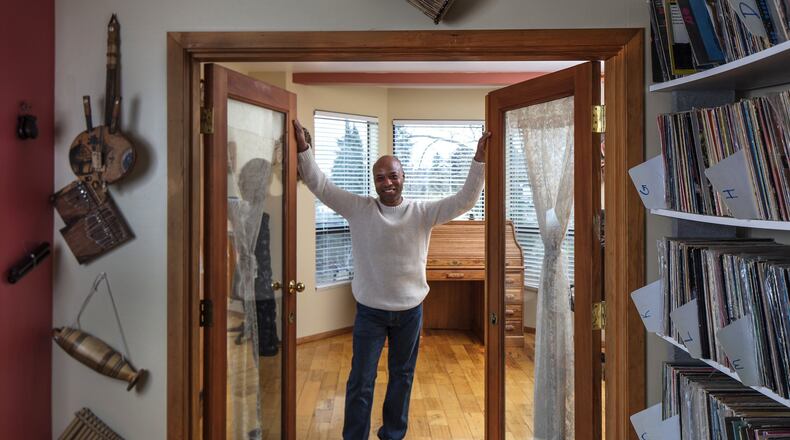SEATTLE — The aged, empty estate had seen better days. Like in 1907, for sure, when the formidable home claimed its hilltop foothold in Rainier Beach. But house and hold had gone decidedly downhill by 1986, when Kevin Howard first encountered the tipsy relic.
“The property was particularly troublesome because the house sat on large boulders as part of the foundation,” Howard says. “Over the decades, the boulders had shifted, causing the house to slip onto the ground.”
Where there’s trouble, there’s often potential — and opportunity. The home was listed for $100,000, Howard says; he paid $48,000.
He then spent 30 years making the home his own — but not necessarily on his own.
His best friend/instigator Leo “was the driving force,” Howard says. “He brought out something in me I didn’t know I could do. He passed away in 1992, but I knew his vision.”
Here’s how it started: “Leo’s ingenious idea was to jack up the house, pour a new foundation and set it back down,” Howard says.
OK, then! (Turns out, that’s exactly what they did.)
As the original vision expanded and evolved, Howard, Leo and a crew of recruited workers who sometimes traded labor for shelter eventually:
— redesigned the entire front of the house and added large, view-capturing windows;
— upgraded the plumbing, wiring and heating;
— built a 2.5-car garage and workspace, with a suite above;
— converted the first-level front rooms into a 1,550-square-foot accessory dwelling unit;
— literally raised the roof to add a new level for a massive master suite;
— resided the entire home;
— and completely refinished 23 rooms, “one level at a time, including seven bedrooms, five bathrooms and two full-size kitchens.”
And that, folks, is how you put the “do” in “do it yourself.”
Today, the once-rocky estate has matured into the quake-stable 6,550-square-foot Leo’s Hideaway. Glance up at the towering triumph, and you’ll spy the hand-painted sign over the new garage — but you won’t see the whole century-spanning story of this colossal project until you step inside … and look down.
Howard, a Vietnam-era veteran who danced professionally for 14 years (including six weeks on a USO tour) while simultaneously working at Boeing, retired in 2011. But in 1990, needing a break from construction, he accepted a two-year work assignment in Atlanta.
While “foraging the Deep South for architectural antiquities,” he came across a barn packed with historic wood outside Macon, Ga.
“Driving there was like driving back 50 years in time,” Howard says.
The barn’s contents — seven species of first-growth hardwood planks — reached back even further: “They were once tobacco-loading docks dating to the early 1800s,” Howard says. “Not only did the platforms endure the slavery days and the Civil War, but they also survived General Sherman’s march to the sea.”
The wood had sat in the barn, aimlessly, for 45 years. “No one knew what to do with it,” Howard says.
He did. Howard spent a week sorting through “massive stacks of planks,” paid $12,000 for 12,000 linear feet of lumber and rented a railroad car for $1,500 to haul it all to Seattle.
And then he installed it, on virtually every floor (only the ADU bedroom retained its original flooring), even in the closets, and even as trim.
Like so many meaningful things, it was not a cakewalk. “The moisture content had changed (in transit), and I had to cut down 7-foot planks to get the waviness out,” Howard says.
Now all that historic wood has a historic home. “I have different species everywhere: red and white oak where everyone is walking — that material will hold up — and hemlock in the closets. You don’t want to mess with that. It’s soft and smells different, and you don’t walk on it a lot.”
Repurposing is a pattern here, on purpose: Bricks from the original chimney now form fish-patterned sidewalks; an original staircase relocated to the new atrium; a salvaged tub sits by a window in the upper-level master suite; and the bed itself grew from an on-site tree felled in 1996.
Howard has his own history of do-it-yourself projects. “This is my fourth house,” he says. “I bought my first one at 21 in Columbia City. I grew up in a middle-class enclave of old black farmers in Plain City, Ohio. One of the farmers was a carpenter and built three or four of those houses, and at 15, we were general laborers. I kind of learned it.”
Howard has no plans whatsoever to ever leave this home — this special, historic hideaway.
“Leo pushed me beyond what I could normally do,” Howard says. “Every room in the house went through two or three iterations over 30 years. Every facet of this, I was doubted, but I look at it now and think, ‘Man; this is very nice. We did this. We pulled this off.’ ”
About the Author
Keep Reading
The Latest
Featured


